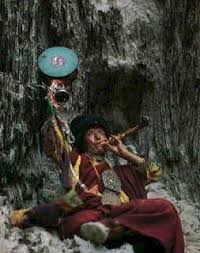Difference between revisions of "Lifestyle of the Chödpas"
(Created page with " chödpa The practitioners of Chöd are called chödpas or yogins. Their lifestyle is an important aspect of this practice. Chödpas live a life...") |
|||
| Line 1: | Line 1: | ||
| − | + | [[File:345es.jpg|thumb]] | |
Latest revision as of 13:15, 8 July 2023
The practitioners of Chöd are called chödpas or yogins. Their lifestyle is an important aspect of this practice. Chödpas live a life similar to the forest tradition. They are not very much concerned with worldly aims and material possessions. Both monastic and lay people can practice Chöd. One aspect of the Chöd ritual is that it is performed at cemeteries. Chödpas wander into these fearful places to perform rituals.
There are several reasons for it. First, chödpas perform at cemeteries because those are said to be the abodes of dakinis and demons. Second, cemeteries are places that enhance the realization of impermanence and one’s own death.
Third, they also practice it them in order to face their greatest fears, notably the fear of death. Fourth, it is a way to test one’s realization of emptiness. Thus, the method of meditating in cemeteries is very conducive for cutting the attachment towards oneself and one’s body.
In sum, in Tibetan Buddhism, Chöd practice is considered one of the most effective meditations to free the meditator of ego-clinging and attachment to the body. Many Tibetan Buddhist masters advise practicing Chöd as they regard it as one of the best and most powerful meditations.
Harding Sarah, in “Machik’s Complete Explanation: Clarifying the Meaning of Chod, A Complete Explanation of Casting Out the Body As Food” (Ithaca: Snow Lion Publication, 2003): 45-51.
Tsultrim Allione, “Machig Lapdron” in Women of Wisdom (New York: Snow Lion Publication, 2000): 169-171.
